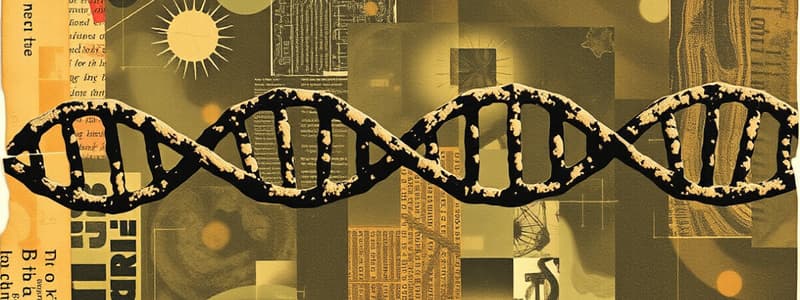Podcast
Questions and Answers
What is DNA?
What is DNA?
- A long linear polymer found in the nucleus of a cell (correct)
- A type of sugar
- A fatty acid
- A type of protein
What are nucleosomes?
What are nucleosomes?
Beads on a string formed by DNA wound around a protein core of histone molecules.
What is chromatin?
What is chromatin?
A combination of DNA and protein molecules in the nucleus of a eukaryotic cell.
What is a hydrogen bond?
What is a hydrogen bond?
What is a complementary strand?
What is a complementary strand?
What is DNA replication?
What is DNA replication?
What is the function of DNA helicase?
What is the function of DNA helicase?
What does DNA polymerase I do?
What does DNA polymerase I do?
What is DNA polymerase III?
What is DNA polymerase III?
What is the role of RNA primase?
What is the role of RNA primase?
What does DNA ligase do?
What does DNA ligase do?
What are Okazaki fragments?
What are Okazaki fragments?
What is a replication fork?
What is a replication fork?
What is the origin of replication?
What is the origin of replication?
What is the semiconservative model?
What is the semiconservative model?
What is the leading strand?
What is the leading strand?
What is the lagging strand?
What is the lagging strand?
What is the role of single-strand binding protein?
What is the role of single-strand binding protein?
What is a mutation?
What is a mutation?
What are carcinogens?
What are carcinogens?
What is transcription?
What is transcription?
What is the sense strand?
What is the sense strand?
What is the antisense strand?
What is the antisense strand?
What is a promoter?
What is a promoter?
What does RNA polymerase do?
What does RNA polymerase do?
What are transcription factors?
What are transcription factors?
What is a terminator?
What is a terminator?
Flashcards are hidden until you start studying
Study Notes
DNA and Its Structure
- DNA (Deoxyribonucleic Acid) is a long polymer located in cell nuclei, composed of nucleotides and structured as a double helix.
- Nucleosomes are structures formed by DNA coiling around a core of eight histone proteins, resembling "beads on a string."
- Chromatin is a complex of DNA and protein fibers that constitutes genetic material in eukaryotic cell nuclei.
Chemical Bonds and Base Pairing
- Hydrogen bonds link complementary base pairs in DNA, involving a hydrogen atom between electronegative atoms (such as oxygen or nitrogen).
DNA Replication Process
- DNA replication is the biological process in which DNA is duplicated prior to cell division through mechanisms like mitosis and meiosis.
- DNA helicase is the enzyme that unwinds the DNA double helix by breaking hydrogen bonds between base pairs.
- DNA Polymerase I removes RNA primers and replaces them with nucleotides, while DNA Polymerase III elongates the DNA strand by adding nucleotides.
- RNA primase synthesizes a short RNA primer needed for DNA replication initiation.
- DNA ligase links DNA fragments together by forming covalent bonds between the growing DNA chain and newly synthesized fragments.
Key Components of DNA Replication
- Okazaki fragments are short DNA sequences synthesized on the lagging strand, later joined together to form a continuous strand.
- The replication fork is a Y-shaped region where parental DNA strands separate, allowing new strands to form.
- The origin of replication is the specific nucleotide sequence that initiates DNA replication.
Models and Mechanisms of DNA Replication
- The semiconservative model of replication results in each new double helix containing one old and one new strand.
- The leading strand is synthesized continuously in the 5' to 3' direction, while the lagging strand is assembled in a discontinuous manner opposite to the direction of unwinding.
Additional Factors in DNA Replication
- Single-strand binding proteins stabilize unpaired DNA strands during replication to prevent them from re-annealing or degrading.
- Mutations are changes in the genetic structure that can result from various factors, including exposure to carcinogens which are substances known to cause cancer.
Transcription Process
- Transcription converts the DNA sequence of a gene into messenger RNA (mRNA).
- The sense strand of DNA is the strand that is transcribed into mRNA and runs from 5' to 3', with thymine replaced by uracil in RNA.
- The antisense strand acts as the template for mRNA synthesis and is the non-coding strand during transcription.
Transcriptional Regulation
- The promoter region on DNA indicates where RNA polymerase binds to initiate transcription.
- RNA polymerase links RNA nucleotides to form a growing mRNA chain based on the DNA template.
- Transcription factors are proteins that regulate the binding of RNA polymerase and help start the transcription process.
- The terminator is a specific nucleotide sequence that signifies the end of gene transcription.
Studying That Suits You
Use AI to generate personalized quizzes and flashcards to suit your learning preferences.




